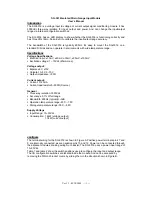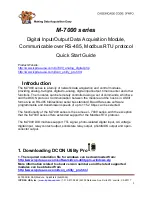
User Guide UG:008
vicorpower.com
800-735-6200
Rev. 1.1
11/10
Page 10 of 19
6.0 Recommended Test Equipment
The following is a list of recommended test equipment. Output load current, and voltage ratings are
a function of the VTM selected (if used).
1. DC Power Supply: 0 – 100 V, 500 W minimum.
a. Set Overvoltage Protection (OVP) based on absolute maximum rating of PRM.
2. Load: Rated appropriately based on output voltage, current, and power requirements. Electronic
load, 0 to 100 V, 130 A minimum recommended.
3. DMM(s).
4. Oscill Probe(s).
5. Interconnect cables and fastening hardware.
6. Calibrated input and output shunts, appropriately rated.
7. Trim Pot screwdriver
8. Fan
9. Data sheets for requisite PRM and VTM devices used.
10. Safety glasses.
7.0 Push Pin Heat Sink Installation
Each PRM and VTM Customer Board comes with its own heat sink and push pins for installation.
Before testing, it is highly recommended that heat sinks be installed in the appropriate location for
each board. When installing the push pin heat sink, use caution not to exceed the maximum
compressive on the device listed in the data sheet.
8.0 Test Configurations
The half-chip PRM-RS Customer Board is designed to work in a number of different configurations as
described in the following section. The scope of this document is limited to describing a single PRM
Customer Board as a stand-alone or connected to a single VTM Customer Board. Other
configurations may be possible, though they cannot be guaranteed to have stable operation with the
components designed onto the board. If testing is to be performed outside of the recommended
configurations, the design should be evaluated to determine if changes to any of the onboard
components are necessary.
8.1 PRM Stand-alone Operation
In this configuration, the PRM output voltage is sensed through the divider formed by R40 and
R23. U09B is configured as a buffer as illustrated in Figure 9, and provides the sense voltage to
the error amplifier (U09A). R24, and R29 are left open, reserved for differential sensing. R40 is
set to limit the upper trim range based on a maximum reference voltage of 1.25 V.
1.24k
R 30
1.24k
R 23
V s-
V s+
PRMO UT
V S+
V S-
TP10
TP11
R4 0
R 24
R 29
6
5
7
U09B
GND
OPEN
OPEN
54.9k
Figure 9: Local Sense
Configuration





































